
Diversity of our flora and fauna
What effect does the BioDiversum have on the animal and plant species living here? In order to be able to assess this in the future, we had experts record the flora and fauna on our institute premises in 2019. We have summarized the most important findings here and asked the experts for a brief assessment.
For us as a research institute, it goes without saying that we want to accompany the BioDiversum scientifically: The development of biodiversity and thus the project’s success must be measurable in the long term. Only then we can assess which of our measures were good and appropriate and where we need to change something.
But in order to know whether the planned measures will increase biodiversity, we first have to find out what is already there. To this end, we recruited renowned experts from the region to record plant species and representative groups of animals and to receive valuable input for the biotope’s design. The experts were out and about on the institute's premises in spring and summer 2019: Gerd Brunken recorded butterflies and grasshoppers, Thomas Fechtler wild bees, Michael Corsmann birds, and Jürgen Rommelmann bats. The vegetation was recorded by Wette + Küneke.
Wild Bees
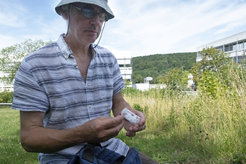
On our institute’s premises, biologist Thomas Fechtler found a great variety of 68 wild bee species, despite mostly unfavorable conditions. 18 of those are endangered or highly endangered in Germany. Ten of the species found are specialized in only one plant family or even only one plant genus as a food source.
Mr Fechtler, you found surprisingly many species of wild bees on our campus. What do think contributes to this?
On one hand, the species´ spectrum recorded shows the high colonization potential of the site, which is located in a structurally relatively rich environment. The identified species survive in still existing microhabitats. Wild bees are biotope complex colonizers, who need to find their specific food plants, suitable nesting structures, or special materials for nest construction close to each other. Individuals can bridge distances of several hundred meters between nest and food plant. Of course, short distances are ideal. Suitable structures on the institutes´ premises are mostly ‘forgotten, messy sites’ – in a positive sense for wild bees! – where indigenous plant species can establish themselves in small areas and come to flower or where small raw soil areas on sunny slopes offer nesting possibilities.
As you found so many species: Do bees not need our support?
I was surprised by the high number of species and especially by the occurrence of rarities, even though the structural diversity on the campus was rather low and the site does not have a particularly high sun exposure. Most of the species, especially the rare ones, were only found in very small individual numbers, sometimes only single individuals were detected. If targeted and appropriate measures are taken, it can be assumed that the wild bee species will be able to react quickly, as they are already present.
Were you particularly pleased about a special species found here?
I was particularly pleased about the detection of both long-horn bee species known to Lower Saxony, the scarce long-horned bee (Eucera nigrescens) and the long-horned bee (Eucera longicornis). Although their specific pollen sources – certain papilionaceous plants – were only found in single plants. Both species are rare or very rare. I could also detect their specific cuckoo bee, the six-banded nomad bee. Until a few years ago, this bee was considered extinct or lost for Lower Saxony, but in the meantime it could very sporadically be found again in southern Lower Saxony. Very remarkable is the wood-carving leafcutter bee (Megachile ligniseca) is present, which has hardly been found in Lower Saxony so far and is also highly endangered throughout Germany. Last but not least, I would like to mention Lasioglossum majus: Whether this single animal is the first evidence for Lower Saxony has still to be clarified, at least I could not find any further evidence within Lower Saxony in the documents available to me.
Which measures could help the bees most?
Two factors are essential: Nesting can be improved by creating raw soil sites and steep earth walls in microclimatically favorable locations, preferably in areas exposed to the south or southwest. About 75 percent of the native wild bee species nest in the ground and depend on such open ground sites. The food situation should also be improved: Promoting species-rich grassland with varied care guarantees flowering food plants throughout the entire vegetation period. Mixtures, should contain plenty of plant species for wild bee species specialized in flowering. Ruderal vegetation, which develops on rubble areas, is particularly valuable, as it contains numerous pollen sources that are particularly valuable for rare wild bee species.
Locusts and butterflies
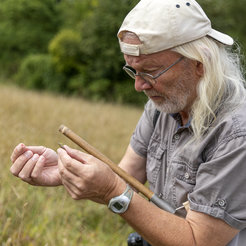
Gerd Brunken found locusts and butterflies almost exclusively on the former horse pasture in the north-east of the institute´s premises, and there in particular on thistles. Among the 21 butterfly species that were each detected with relatively few individuals, the meadow brown (Maniola jurtina) was dominant. In addition, the common blue (Polyommatus Icarus) and the small heath (Coenonympha pamphilus) were more common. The few locust species, on the other hand, populated the pasture by thousands in summer, the dominant species being the lesser marsh grasshopper Chorthippus albomarginatus.
Mr. Brunken, you have found relatively few and also common species of butterflies and grasshoppers on our property. Did that surprise you?
Well, that´s not quite true. Among the butterflies, there were some quite remarkable species. For the locusts, however, the observation is correct. I had not expected a larger species spectrum in this group, because there are no habitats in the study area where rarer grasshopper species usually live. For the butterflies I had hoped for one or the other species beyond the spectrum found.
Some otherwise common butterfly species are missing in your report, for example the small tortoiseshell. What could be the reason for this?
The small tortoiseshell had an extremely bad year 2019, which is also true – with slight limitations – for the three common pieridae, for example. Admirals startet to appear no earlier than late summer and autumn, when there were no food plants left for the imagines – the adult butterflies.
Do locusts and butterflies benefit from the creation of a pond?
No. Dragonflies, however, would settle very quickly.
Can flightless insects travel greater distances and settle here?
There are grasshopper species that are, in principle, unable to fly. However, some of these species also form long-winged individuals that fly well and can thus cover longer distances. In general, insects that are unable to fly can also travel greater ranges, for example by wind drift or by being transported along traffic routes.
Birds
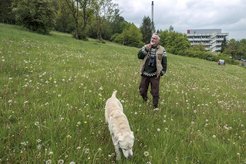
Mr Corsmann, were there any surprises during your recording of species?
No, not really.
Which rare species could become native here if we create the right conditions?
With a pond on the premises, it would enable reed warblers to live here, and of course also ducks – initially mallards – and pond fowls. Creating a nutrient-poor meadow would increase the biodiversity of insects. This would suit the red-backed shrike, in the best case also the wryneck and the hoopoe – the latter was seen there once or twice years ago!
20 percent of the birds you found here are cave breeders. What should we in particular pay attention to when designing the biotope to support these species?
It is of course important to preserve old trees, even and especially when they are already dead. But suitable nesting aids can help, as well. We would then have to talk about which species we want to support. I have the pied flycatcher in mind, for example.
Bats
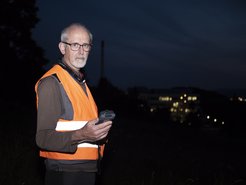
Bat expert Jürgen Rommelmann was able to prove the calls of seven bat species on campus, all of which are on the Red List. The most common bat flying here was the common pipistrelle (Pipistrellus pipistrellus), which is also the most common bat in Germany, and its closely relative soprano pipistrelle (Pipistrellus pygmaeus). Rommelmann found no bat quarters.
Mr. Rommelmann, you have recorded seven species of bats on site – that sounds quite impressive at first. Is that how you see it?
From an ecological point of view, this is a pleasing result that reflects the already existing heterogeneity of the site. Although the common pipistrelle, which is widespread in Germany, dominated, the evidence of other species shows that this is an attractive hunting ground for many species.
What can we do to ensure that bats find accommodation here?
I am sure that summer quarters already exist in the natural tree structures. However, reliable detection often requires a much higher methodological effort with netting and telemetry. In addition, the installation of bat boxes would also improve the range of quarters on offer.
Do more insects on the institute premises automatically mean more bats?
Sure, if there is a lot of food, there is a correspondingly large number of eating guests. In this respect, a diverse and individual-rich insect fauna is also attractive for bats.
European hamster
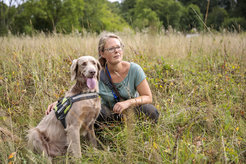
(Recording: Mareike Schneider and her dog Smilla)
- No evidence
Flora
(Recording: Wette + Küneke)
- High proportion of intensive grassland and lawn
- Green areas close to buildings are partly already planted with flowering bushes
- Grounds and roadside areas have been intensively managed so far and have high potential for upgrading
- Some trees are not suitable for the site (Note: Unsuitable spruces were felled in autumn 2019 as the population was massively infested by the bark beetle)




